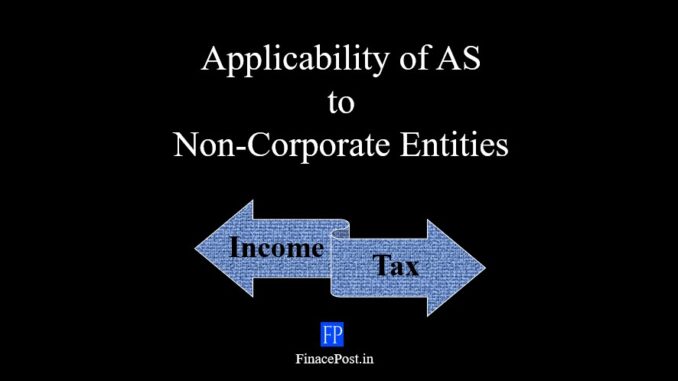
Last updated on July 30th, 2022 at 08:33 pm
Applicability of AS to Non-Corporate Entities
ICAI has revised the classification criteria of Non-Corporate entities. Based on the classification of such Non-company entities, the applicability of Accounting Standards will be determined. Entities at levels II, III, and IV will be referred to as Micro, Small & Medium Size Entities commonly known as MSMEs.
Classification Criteria of Non-company entities
Level I – Large Size Entities
- Non Corporate Entities whose securities are listed on any stock exchange in India or outside India.
- Non Corporate Entities whose securities are in the process of listing on any stock exchange in India or outside India.
- Banks including co-operative banks
- Financial institutions
- Insurance business entities
- An entity engaged in commercial, industrial, or business activities
- If turnover exceeds Rs 250 Crores in the immediately preceding accounting year. (Other income will not be included)
- If borrowing exceeds Rs 50 Crores in the immediately preceding accounting year. (Public deposits will be included)
- Holding and subsidiary entities of any one of the above.
Level II – Medium-Size Entities
- An entity that does not qualify as a Level I entity.
- An entity engaged in commercial, industrial, or business activities
- If turnover ranges between Rs 50 – Rs 250 Crores in the immediately preceding accounting year. (Other income will not be included)
- If borrowing ranges between Rs 10 – Rs 50 Crores in the immediately preceding accounting year. (Public deposits will be included)
- Holding and subsidiary entities of any one of the above.
Level III – Small Size Entities
- An entity that does not qualify as a Level I or Level II entity.
- An entity engaged in commercial, industrial, or business activities
- If turnover ranges between Rs 10 – Rs 50 Crores in the immediately preceding accounting year. (Other income will not be included)
- If borrowing ranges between Rs 2 – Rs 10 Crores in the immediately preceding accounting year. (Public deposits will be included)
- Holding and subsidiary entities of any one of the above.
Level IV – Micro Size Entities
- An entity that does not qualify as a Level I or Level II or Level III entity.
List of applicable Accounting Standards based on categories
Level I – Large Size Entities
All accounting standards need to be complied with in full.
Level II – Medium-Size Entities
AS 1 – Disclosure of Accounting Policies
AS 2 – Valuation of Inventories
AS 4 – Contingencies and Events Occurring After the Balance Sheet Date
AS 5 – Net Profit or Loss for the Period, Prior Period Items, and Changes in Accounting Policies
AS 7 – Construction Contracts
AS 9 – Revenue Recognition
AS 10 – Property, Plant, and Equipment
AS 11 – The Effects of Changes in Foreign Exchange Rates
AS 12 – Accounting for Government Grants
AS 13 – Accounting for Investments
AS 14 – Accounting for Amalgamations
AS 15 – Employee Benefits (Note 1)
AS 16 – Borrowing Costs
AS 18 – Related Party Disclosures
AS 19 – Leases (Note 2)
AS 22 – Accounting for Taxes on Income
AS 24 – Discontinuing Operations
AS 26 – Intangible Assets
AS 28 – Impairment of Assets (Note 2)
AS 29 – Provisions, Contingent Liabilities, and Contingent Assets (Note 2)
Level III – Small-Size Entities
AS 1 – Disclosure of Accounting Policies
AS 2 – Valuation of Inventories
AS 4 – Contingencies and Events Occurring After the Balance Sheet Date
AS 5 – Net Profit or Loss for the Period, Prior Period Items, and Changes in Accounting Policies
AS 7 – Construction Contracts
AS 9 – Revenue Recognition
AS 10 – Property, Plant, and Equipment (Note 2)
AS 11 – The Effects of Changes in Foreign Exchange Rates (Note 2)
AS 12 – Accounting for Government Grants
AS 13 – Accounting for Investments
AS 14 – Accounting for Amalgamations
AS 15 – Employee Benefits (Note 1)
AS 16 – Borrowing Costs
AS 19 – Leases (Note 2)
AS 22 – Accounting for Taxes on Income
AS 26 – Intangible Assets
AS 28 – Impairment of Assets (Note 2)
AS 29 – Provisions, Contingent Liabilities, and Contingent Assets (Note 2)
Level IV – Micro-Size Entities
AS 1 – Disclosure of Accounting Policies
AS 2 – Valuation of Inventories
AS 4 – Contingencies and Events Occurring After the Balance Sheet Date
AS 5 – Net Profit or Loss for the Period, Prior Period Items, and Changes in Accounting Policies
AS 7 – Construction Contracts
AS 9 – Revenue Recognition
AS 10 – Property, Plant, and Equipment (Note 2)
AS 11 – The Effects of Changes in Foreign Exchange Rates (Note 2)
AS 12 – Accounting for Government Grants (Note 2)
AS 13 – Accounting for Investments (Note 2)
AS 14 – Accounting for Amalgamations
AS 15 – Employee Benefits (Note 1)
AS 16 – Borrowing Costs
AS 19 – Leases (Note 2)
AS 22 – Accounting for Taxes on Income
AS 26 – Intangible Assets (Note 2)
AS 28 – Impairment of Assets (Note 2)
Note 1 – Accounting Standards to the concerned non-corporate entity will be applicable with exemptions.
Note 2 – Accounting Standards to the concerned non-corporate entity will be applicable with disclosure exemptions.
Related Posts
- 50th GST Council Meeting - 11/07/2023
- GST Compliance Calendar of October 2023 - 01/04/2023
- GST sections amended in Finance Act 2023 - 27/03/2023
Disclaimer: The above content is for general info purpose only and does not constitute professional advice. The author/ website will not be liable for any inaccurate / incomplete information and any reliance you place on the content is strictly at your risk.
Follow us on Social Media by clicking below
Follow @financepost_in
Great blog post
Thank you for the valuable feedback and appreciation.